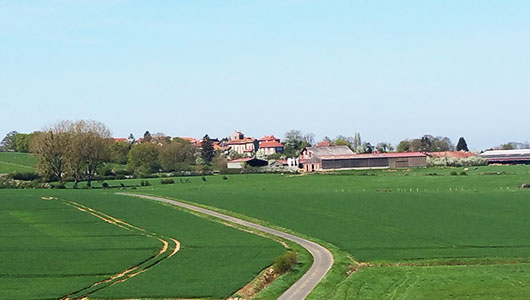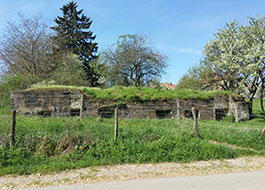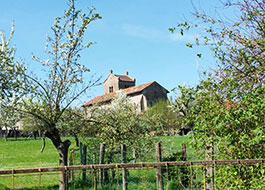Lemoncourt
Durée visite : 30 minutes
Moyen : Pédestre
Le village appartenait au ban de Delme. Il fut possession des abbayes de Saint-Arnoul et de Saint-Vincent de Metz. L’abbaye Saint-Arnould, ou abbaye des Saints-Apôtres, est une abbaye bénédictine fondée à Metz au VIe siècle. Charlemagne fit de cette abbaye la nécropole d’une partie de sa famille. Sa femme Hildegarde, ses sœurs, ses fils, Louis le Pieux et l’évêque Drogon y furent enterrés.
L’abbaye Saint-Vincent de Metz est une abbaye bénédictine, fondée à Metz au Xe siècle Parmi les possessions de l’abbaye durant le Moyen Âge, on peut citer les villages de Amanvillers, Borny, Châtel-Saint-Germain, Laquenexy, La Maxe, Maizières-lès-Metz. Une foire se tenait au XVe siècle dans le village. En 1661, celui-ci fut cédé à la France par le duc de Lorraine.
The village belonged to the ban of Delme. It was owned by the abbeys of Saint-Arnoul and Saint-Vincent de Metz. The Saint-Arnould abbey, or Saints-Apostles abbey, is a Benedictine abbey founded in Metz in the 6th century. Charlemagne made this abbey the necropolis of part of his family. His wife Hildegard, his sisters, his sons, Louis the Pious and Bishop Drogon were buried there.
The Saint-Vincent de Metz abbey is a Benedictine abbey, founded in Metz in the 10th century. Among the possessions of the abbey during the Middle Ages, we can mention the villages of Amanvillers, Borny, Châtel-Saint-Germain, Laquenexy, La Maxe, Maizières-lès-Metz. A fair was held in the 15th century in the village. In 1661, it was ceded to France by the Duke of Lorraine.
Das Dorf gehörte zum Verbot von Delme. Es war im Besitz der Abteien von Saint-Arnoul und Saint-Vincent de Metz. Die Abtei Saint-Arnould oder die Abtei der Heiligen Apostel ist eine Benediktinerabtei, die im 6. Jahrhundert in Metz gegründet wurde. Karl der Große machte diese Abtei zur Nekropole eines Teils seiner Familie. Dort wurden seine Frau Hildegard, seine Schwestern, seine Söhne Ludwig der Fromme und Bischof Drogon beigesetzt.
Die Abtei Saint-Vincent de Metz ist eine Benediktinerabtei, die im 10. Jahrhundert in Metz gegründet wurde. Zu den Besitztümern der Abtei im Mittelalter zählen die Dörfer Amanvillers, Borny, Châtel-Saint-Germain, Laquenexy, La Maxe, Maizières-lès-Metz. Im 15. Jahrhundert fand im Dorf eine Messe statt. 1661 wurde es vom Herzog von Lothringen an Frankreich abgetreten.

D’azur à la fasce d’or accompagnée en chef d’une étoile aussi d’or et en pointe d’un croissant d’argent.
Armes des Protin, seigneurs au XVIIIe siècle, avec le croissant symbolisant la Nativité de la Vierge, patronne de l’église.
Azure, a fess Or accompanied in chief of a star also Or and in base of a crescent Argent.
Arms of the Protins, lords in the 18th century, with the crescent symbolizing the Nativity of the Virgin, patron saint of the church.
Azure, ein Fess oder als Chef eines Sterns auch begleitet oder und in Basis eines sichelförmigen Argent.
Wappen der Protins, Herren im 18. Jahrhundert, mit dem Halbmond als Symbol für die Geburt der Jungfrau Maria, Schutzpatronin der Kirche.

Les loups de L’mocôt = les loups de Lemoncourt.
Ce féroce animal figure dans le blason populaire de 20 localités du département. Très rusé et très méfiant, le loup a reçu de la nature les moyens de satisfaire son violent appétit. il a l’odeur d’une finesse extrême; nul ne sait mieux éviter un piège. Comme d’autres carnassiers, il a la faculté de flairer sa route à travers une région, nouvelle pour lui; c’est un sixième sens que l’homme ne possède pas. On conçoit donc bien que cette bête cruelle ait pu hanter les longues veillées au coin de l’âtre dans les campagnes désertes et que ses carnages que nos aïeux se plaisaient à raconter, aient pu angoisser les adultes et troubler le sommeil des enfants. Aussi ne peut – on se montrer étonné quand la tradition nous apprend que le loup passait pour une créature du mal. Autrefois, on parlait souvent de » meneurs de loups « , qui n’étaient rien moins que des sorciers qui usaient de leur pouvoir magique pour gouverner la bête à leur gré : l’éloigner du troupeau pour le sauvegarder ou abandonner les moutons dans la bergerie à sa voracité pour assouvir une vengeance. Les habitants de Lemoncourt avaient autrefois la réputation d’être rusés voir redoutable en affaire.
Réf. L’Evangile des Ivrognes (Version d’Attilloncourt)
Les loups de L’mocôt = the wolves of Lemoncourt.
This ferocious animal appears in the popular coat of arms of 20 localities in the department. Very cunning and very suspicious, the wolf has received from nature the means to satisfy its violent appetite. it has the smell of extreme finesse; no one knows better how to avoid a trap. Like other predators, he has the ability to sniff his route through a region new to him; it is a sixth sense that man does not have. It is therefore easy to imagine that this cruel beast could have haunted the long evenings at the corner of the hearth in the deserted countryside and that its carnages that our ancestors liked to tell, could have distressed the adults and disturbed the sleep of the children. So we can not be surprised when tradition teaches us that the wolf passed for an evil creature. In the past, we often spoke of « wolf leaders », who were nothing less than wizards who used their magical power to rule the beast as they pleased: take it away from the flock to save it or abandon the sheep in the sheepfold. to his voracity to satisfy a vengeance. The inhabitants of Lemoncourt once had the reputation of being cunning and even formidable in business.
Ref. The Gospel of the Drunkards (Attilloncourt version)
Les loups de L’mocôt = die Wölfe von Lemoncourt.
Dieses wilde Tier erscheint im beliebten Wappen von 20 Orten in der Abteilung. Sehr gerissen und sehr misstrauisch, hat der Wolf von der Natur die Mittel erhalten, um seinen heftigen Appetit zu stillen. es riecht nach extremer Finesse; Niemand weiß besser, wie man einer Falle aus dem Weg geht. Wie andere Raubtiere hat er die Fähigkeit, seine Route durch eine für ihn neue Region zu beschnüffeln. Es ist ein sechster Sinn, den der Mensch nicht hat. Es ist daher leicht vorstellbar, dass dieses grausame Tier die langen Mahnwachen an der Ecke des Herdes in der verlassenen Landschaft heimgesucht haben könnte und dass seine Gemetzel, die unsere Vorfahren gern erzählten, Erwachsene in Bedrängnis gebracht und den Schlaf von Kindern gestört haben könnten. Wir können uns also nicht wundern, wenn uns die Tradition lehrt, dass der Wolf als böse Kreatur galt. In der Vergangenheit sprachen wir oft von « Wolfsführern », die nichts weniger als Zauberer waren, die ihre magische Kraft nutzten, um das Tier nach Belieben zu regieren: Nehmen Sie es von der Herde weg, um es zu retten, oder lassen Sie die Schafe im Schafstall zurück. zu seiner Unlust, eine Rache zu befriedigen. Die Einwohner von Lemoncourt hatten einst den Ruf, gerissen und sogar im Geschäft beeindruckend zu sein.
Ref. Das Evangelium der Betrunkenen (Attilloncourt-Version)
Les points de visites
.
Un bunker est situé à l’entrée du village. Il a été construit par les Allemands en 1917. Cette date est inscrite au dessus d’une ouverture. Le nom d’Ehrenbreitstein figure au dessus. C’est une allusion, ambitieuse, à une fortification plus impressionnante. La forteresse d’Ehrenbreitstein se trouve sur le rocher du même nom. Elle culmine à 118 mètres au-dessus du Rhin, à son confluent avec la Moselle, en face de la ville de Coblence. Si le lieu est occupé depuis très longtemps en raison de sa position stratégique, les fortifications actuelles datent du XIXe siècle. Elles comptent parmi les plus puissantes et les mieux conservées en Allemagne. Durant la Première Guerre mondiale, des Mosellans et des Alsaciens francophiles y sont symboliquement incarcérés.
A bunker is located at the entrance to the village. It was built by the Germans in 1917. This date is inscribed above an opening. Ehrenbreitstein’s name appears above. It is an ambitious allusion to a more impressive fortification. Ehrenbreitstein Fortress is located on the rock of the same name. It culminates at 118 meters above the Rhine, at its confluence with the Moselle, opposite the city of Koblenz. If the place has been occupied for a very long time because of its strategic position, the current fortifications date from the 19th century. They are among the most powerful and best preserved in Germany. During the First World War, Mosellans and Alsatians Francophiles were symbolically imprisoned there.
Ein Bunker befindet sich am Dorfeingang. Es wurde 1917 von den Deutschen erbaut. Dieses Datum ist über einer Öffnung eingeschrieben. Ehrenbreitsteins Name erscheint oben. Es ist eine ehrgeizige Anspielung auf eine eindrucksvollere Festung. Die Festung Ehrenbreitstein befindet sich auf dem gleichnamigen Felsen. Sie gipfelt 118 Meter über dem Rhein am Zusammenfluss mit der Mosel gegenüber der Stadt Koblenz. Wenn der Ort aufgrund seiner strategischen Lage schon sehr lange besetzt ist, stammen die heutigen Befestigungsanlagen aus dem 19. Jahrhundert. Sie gehören zu den mächtigsten und am besten erhaltenen in Deutschland. Während des Ersten Weltkriegs wurden Mosellaner und Elsässer Frankophile dort symbolisch inhaftiert.
.
.
Cette église dépendait à la fois des abbayes messines Sainte-Glossinde et Saint-Vincent. Elle a été construite vers la fin du XIIe siècle. Au cours du deuxième quart du XIIIe siècle, l’église est en partie reconstruite. La nef reçoit un voûtement sur croisées d’ogives. La façade se dote d’un superbe portail du 1er âge gothique . Son tympan figure le Couronnement de la Vierge. Au XIVe siècle, les voûtes sont refaites et des restaurations sont effectuées au XIXe siècle. Enfin, l’édifice est classé monument historique en 1930.
Le clocher est encore de tradition romane. Ses baies géminées et ses archères à étrier en triangle sont remarquables. Il domine toujours l’église du deuxième quart du XIIIe siècle. La façade comporte un très beau portail du 1er âge gothique avec un tympan historié montrant le Couronnement de la Vierge par le Christ, situé à sa droite. On note deux saints agenouillés. Le diacre Saint-Vincent, à droite, tient dans ses mains la palme du martyr. Sainte-Glossinde, à gauche, a les mains jointes. Elle se tient sous un dais tenus par deux anges, un la surplombant et l’autre juste derrière elle. La présence de ses deux saints-patrons rappelle que l’église de Lemoncourt relevait des abbayes Saint-Vincent et Sainte-Glossinde de Metz. Le remarquable tympan est encadré par des voussures en plein cintre encore bien romanes. Il retombe sur les chapiteaux à crochets soutenus par les colonnes des pieds-droits. En ce qui concerne l’influence artistique, la Vierge du tympan a des ressemblances avec la Vierge de la Visitation de la cathédrale de Reims.
A l’intérieur, la nef unique est courte avec deux travées. Elle se finie par un chœur à chevet plat doté de trois fenêtres en plein cintre. Cela rappelle quelque peu l’art cistercien. La nef est voûtée sur croisées d’ogives. Elle date des XIIIe-XIVe siècles. Elle comporte des clefs de voûte tantôt à fleurons, tantôt à petits personnages et animaux. La nef présente des sculptures ornementales de toute beauté comme les statues-colonnes à la retombée des voûtes.Ils représentent notamment des anges. On découvre également des chapiteaux différents. Ils sont souvent à feuillages et, pour certains, encore romans dans leur conception, puisqu’on retrouve des palmettes et entrelacs. On remarque aussi des têtes d’hommes et de femmes, toujours à la retombée des voûtes. Certains les identifient comme la Vierge, Sainte-Anne, le Christ.
This church depended on both the Sainte-Glossinde and Saint-Vincent Metz abbeys. It was built towards the end of the 12th century. During the second quarter of the 13th century, the church was partly rebuilt. The nave has a vaulted vault. The facade has a superb portal from the 1st Gothic age. Its tympanum represents the Coronation of the Virgin. In the 14th century, the vaults were redone and restorations were carried out in the 19th century. Finally, the building was classified as a historical monument in 1930.
The bell tower is still of Romanesque tradition with its twin bays and its archers with triangular stirrups. It still dominates the church from the second quarter of the 13th century. The facade has a very beautiful portal from the 1st Gothic age with a historiated tympanum showing the Coronation of the Virgin by Christ, located to its right. There are two kneeling saints. The deacon Saint-Vincent, on the right, holds the palm of the martyr in his hands. Sainte-Glossinde, on the left, has her hands clasped. She is standing under a canopy held by two angels, one overhanging her and the other just behind her. The presence of its two patron saints reminds us that the church of Lemoncourt came under the abbeys of Saint-Vincent and Sainte-Glossinde de Metz. The remarkable tympanum is framed by semi-circular arches which are still very Romanesque. It falls on the hooked capitals supported by the columns of the upright legs. Regarding artistic influence, the Virgin of the tympanum bears resemblances to the Virgin of the Visitation of the portal of Reims Cathedral.
Inside, the single nave is short with two bays. It ends with a choir with a flat apse with three semicircular windows. It is somewhat reminiscent of Cistercian art. The nave is vaulted on cross ribs. It dates from the 13th-14th centuries. It has keystones, sometimes with fleurons, sometimes with small figures and animals. The nave presents ornamental sculptures of great beauty, such as the statues-columns hanging from the vaults, in particular representing angels. We also discover different capitals. They are often foliage and, for some, still romance in their design, since we find palmettes and interlacing. We also notice the heads of men and women, still hanging from the vaults. Some identify them as the Virgin, Saint Anne, Christ.
Diese Kirche war sowohl von den Abteien Sainte-Glossinde als auch Saint-Vincent Metz abhängig. Es wurde gegen Ende des 12. Jahrhunderts erbaut. Im zweiten Viertel des 13. Jahrhunderts wurde die Kirche teilweise wieder aufgebaut. Das Kirchenschiff hat ein Gewölbe. Die Fassade hat ein prächtiges Portal aus der 1. Gotik. Sein Tympanon repräsentiert die Krönung der Jungfrau. Im 14. Jahrhundert wurden die Gewölbe erneuert und im 19. Jahrhundert restauriert. Schließlich wurde das Gebäude 1930 als historisches Denkmal eingestuft.
Der Glockenturm hat noch immer romanische Tradition mit seinen Doppelbuchten und seinen Bogenschützen mit dreieckigen Steigbügeln. Es dominiert noch immer die Kirche aus dem zweiten Viertel des 13. Jahrhunderts. Die Fassade hat ein sehr schönes Portal aus der 1. Gotik mit einem historischen Tympanon, das rechts die Krönung der Jungfrau von Christus zeigt. Es gibt zwei kniende Heilige. Der Diakon Saint-Vincent rechts hält die Handfläche des Märtyrers in seinen Händen. Sainte-Glossinde, links, hat die Hände gefaltet. Sie steht unter einem Baldachin, der von zwei Engeln gehalten wird, von denen einer über ihr und der andere direkt hinter ihr hängt. Die Anwesenheit seiner beiden Schutzheiligen erinnert uns daran, dass die Kirche von Lemoncourt unter die Abteien von Saint-Vincent und Sainte-Glossinde de Metz kam. Das bemerkenswerte Tympanon wird von halbkreisförmigen Bögen eingerahmt, die noch sehr romanisch sind. Es fällt auf die hakenförmigen Hauptstädte, die von den Säulen der aufrechten Beine getragen werden. In Bezug auf den künstlerischen Einfluss hat die Jungfrau des Tympanons Ähnlichkeiten mit der Jungfrau der Heimsuchung des Portals der Kathedrale von Reims.
Im Inneren ist das einzelne Kirchenschiff kurz mit zwei Buchten. Es endet mit einem Chor mit einer flachen Apsis mit drei halbkreisförmigen Fenstern. Es erinnert etwas an die Kunst der Zisterzienser. Das Kirchenschiff ist auf Querrippen gewölbt. Es stammt aus dem 13.-14. Jahrhundert. Es hat Schlusssteine, manchmal mit Fleurons, manchmal mit kleinen Figuren und Tieren. Das Kirchenschiff zeigt dekorative Skulpturen von großer Schönheit, wie die Statuen-Säulen, die an den Gewölben hängen und insbesondere Engel darstellen. Wir entdecken auch verschiedene Hauptstädte. Sie sind oft Laub und für manche immer noch romantisch in ihrem Design, da wir Palmetten und Interlacing finden. Wir bemerken auch die Köpfe von Männern und Frauen, die immer noch an den Gewölben hängen. Einige identifizieren sie als die Jungfrau, Heilige Anna, Christus.







